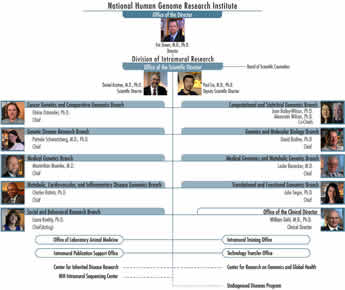Last updated: May 19, 2014
NHGRI's Division of Intramural Research implements new structure to adapt to the dynamic genomics era
NHGRI's Division of Intramural Research implements new structure to adapt to the dynamic genomics era
Three new branch chiefs assume intramural leadership positions
By Raymond MacDougall
Associate Director of Communications, Division of Intramural Research
The rapidly changing world of genomics research requires an adaptable organization, according to a Blue Ribbon Panel report on the National Human Genome Research Institute (NHGRI) Division of Intramural Research (DIR). Concurring with this observation, NHGRI Scientific Director Daniel Kastner, M.D., Ph.D., has implemented a reorganization of NHGRI's 45 intramural investigators and associated research programs into a new arrangement of nine branches.
"We have had an overwhelmingly positive response to the reorganization," Dr. Kastner said. "Our objectives include catalyzing new scientific synergies and optimizing the extraordinary talents of our research and clinical faculty."
The reorganization of the NHGRI Intramural Research Program includes the appointment of three new branch chiefs.
The revised NHGRI branch structure includes three new branches and two that have been renamed to reflect their updated missions.
- Cancer Genetics and Comparative Genomics Branch (formerly the Cancer Genetics Branch)
- Computational and Statistical Genomics Branch (formerly the Inherited Disease Research Branch)
- Genetic Disease Research Branch
- Genetics and Molecular Biology Branch
- Metabolic, Cardiovascular and Inflammatory Disease Branch (new)
- Medical Genetics Branch
- Medical Genomics and Metabolic Genetics Branch (new)
- Social and Behavioral Research Branch
- Translational and Functional Genomics Branch (new)
Investigators formerly part of the Genome Technology Branch, which has been dissolved, are now affiliated with other intramural branches.
Three senior investigators have been named to the role of chief within their respective branches. These include:
- Charles Rotimi, Ph.D., chief, Metabolic, Cardiovascular and Inflammatory Disease Branch
 Dr. Rotimi is an epidemiologist with expertise in statistics and genetics. He studies the role that culture, lifestyle and genomics play in disease etiology, health disparities and variable drug response. His laboratory develops genetic epidemiology models and conducts epidemiologic studies that explore the patterns and determinants of common complex diseases in human populations with particular emphasis on populations of the African Diaspora. Dr. Rotimi's group published the first genome-wide scan for hypertension and blood pressure in African Americans and for type 2 diabetes in West Africans.
Dr. Rotimi is an epidemiologist with expertise in statistics and genetics. He studies the role that culture, lifestyle and genomics play in disease etiology, health disparities and variable drug response. His laboratory develops genetic epidemiology models and conducts epidemiologic studies that explore the patterns and determinants of common complex diseases in human populations with particular emphasis on populations of the African Diaspora. Dr. Rotimi's group published the first genome-wide scan for hypertension and blood pressure in African Americans and for type 2 diabetes in West Africans.Dr. Rotimi's NHGRI laboratory, established with his arrival at NIH in 2008, contributes to the global understanding of human genetic variation by actively participating in the development of international genomic resources, including the HapMap, the 1000 Genomes and the African Genome Variation Project. In addition to his NHGRI branch role, he is director of the NIH Center for Research on Genomics and Global Health. He is on the Executive and Scientific Committee for the International Federation of Human Genetics Societies and was recently elected to the Human Genome Organization (HUGO) Council. He is the founding and past president of the African Society of Human Genetics (AfSHG). He is on the editorial board of Public Health Genomics, Genome Medicine, Clinical Genetics and the Journal of Applied and Translational Genomics and is on the Coriell Personalized Medicine Collaborative Board. He was recently awarded an honorary professorship at the University of Cape Town, South Africa.
Recently, Dr. Rotimi played a major role in the establishment of the Human Heredity and Health in Africa (H3Africa) initiative, with a $76 million commitment from NIH and the Wellcome Trust. H3Africa will create and support a network of research groups that will conduct leading-edge research into the genetic and environmental determinants of diseases in Africans and people of African descent.
Along with a B.S. from the University of Benin, Nigeria, Dr. Rotimi obtained a B.S. from the University of Mississippi and a M.P.H. and Ph.D. from the University of Alabama at Birmingham.
- Pamela Schwartzberg, M.D., Ph.D., chief, Genetic Disease Research Branch
 Dr. Schwartzberg launched her research at NHGRI in 1997 and currently studies T lymphocyte signaling pathways with an emphasis on understanding pathways that are affected by primary immunodeficiencies and how these pathways regulate normal immune cell development and function.
Dr. Schwartzberg launched her research at NHGRI in 1997 and currently studies T lymphocyte signaling pathways with an emphasis on understanding pathways that are affected by primary immunodeficiencies and how these pathways regulate normal immune cell development and function.Employing a multidisciplinary approach that uses mouse genetics, cell biology, biochemistry and genomics, coupled with studies of infectious disease and immunization, Dr. Schwartzberg's laboratory examines the functions of signaling molecules in T lymphocytes, with an emphasis on tyrosine phosphorylation-based pathways. The goals are to understand the pathophysiology of primary immunodeficiencies, as well as to provide insight into the normal regulation of the immune system and the regulation of responses to infection and immunization.
Dr. Schwartzberg obtained her B.A. from Princeton University and her M.D. and Ph.D. from Columbia University College of Physicians and Surgeons, New York, New York. She completed a residency at Boston Children's Hospital and a postdoctoral fellowship at NIH, where she studied mouse genetics and molecular immunology.
- Julie Segre, Ph.D., chief, Translational and Functional Genomics Branch
 Dr. Segre joined NHGRI's Division of Intramural Research in 2000 and, since 2007, has held the title of senior investigator. She studies microbial genomics, focused particularly on the microbes that inhabit the human skin and on tracking hospital outbreaks of multi-drug resistant bacteria. In her role as a mentor to postdoctoral fellows, she seeks to instill expertise in computational biology and team science, integrating basic and clinical research. In her research, Dr. Segre collaborates closely with the NIH Clinical Center's hospital epidemiology, microbiology and dermatology departments and with the NIH Intramural Sequencing Center.
Dr. Segre joined NHGRI's Division of Intramural Research in 2000 and, since 2007, has held the title of senior investigator. She studies microbial genomics, focused particularly on the microbes that inhabit the human skin and on tracking hospital outbreaks of multi-drug resistant bacteria. In her role as a mentor to postdoctoral fellows, she seeks to instill expertise in computational biology and team science, integrating basic and clinical research. In her research, Dr. Segre collaborates closely with the NIH Clinical Center's hospital epidemiology, microbiology and dermatology departments and with the NIH Intramural Sequencing Center.
Dr. Segre obtained her B.A. summa cum laude in mathematics from Amherst College and her Ph.D. from Massachusetts Institute of Technology. She received a Damon Runyon postdoctoral fellowship and completed her training in skin biology at the University of Chicago. In 2000, Segre received a Burroughs Wellcome Career Award.With NIH colleagues, Dr. Segre received the 2013 Service to America Medal and the 2012 NIH Director's Award for developing whole-genome sequencing to track a hospital outbreak. She serves on the board of trustees of Amherst College.
"The appointment of these outstanding scientists to key leadership posts within the scientific infrastructure of our Division of Intramural Research speaks to their accomplishments in their respective scientific disciplines and to their esteemed stature throughout the NIH community," Dr. Kastner said.
To view the enlarged illustration PDF on this page, you will need Adobe Reader. ![]()
Posted: May 19, 2014
